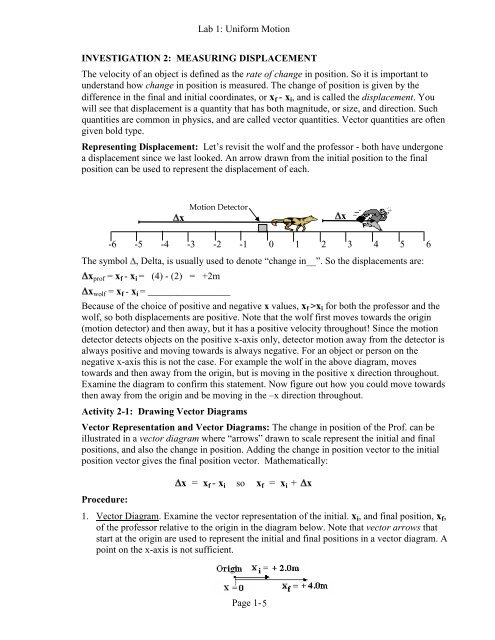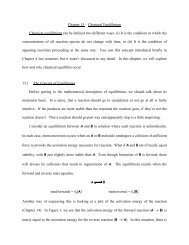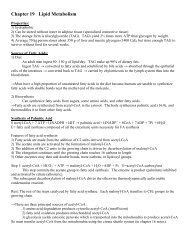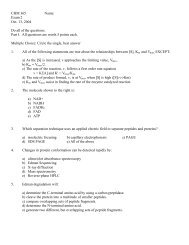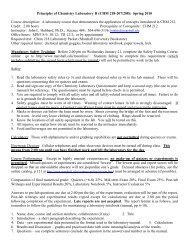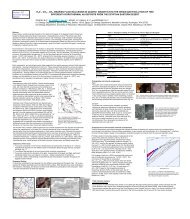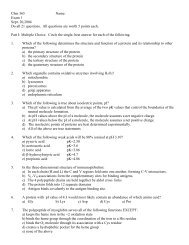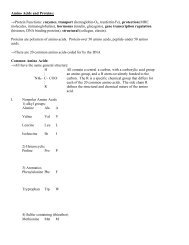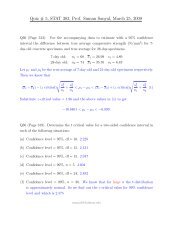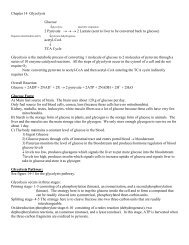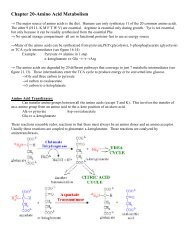LAB 1: INTRODUCTION TO MOTION
LAB 1: INTRODUCTION TO MOTION
LAB 1: INTRODUCTION TO MOTION
You also want an ePaper? Increase the reach of your titles
YUMPU automatically turns print PDFs into web optimized ePapers that Google loves.
Lab 1: Uniform Motion<br />
INVESTIGATION 2: MEASURING DISPLACEMENT<br />
The velocity of an object is defined as the rate of change in position. So it is important to<br />
understand how change in position is measured. The change of position is given by the<br />
difference in the final and initial coordinates, or x f - x i , and is called the displacement. You<br />
will see that displacement is a quantity that has both magnitude, or size, and direction. Such<br />
quantities are common in physics, and are called vector quantities. Vector quantities are often<br />
given bold type.<br />
Representing Displacement: Let’s revisit the wolf and the professor - both have undergone<br />
a displacement since we last looked. An arrow drawn from the initial position to the final<br />
position can be used to represent the displacement of each.<br />
x<br />
Motion Detector<br />
x<br />
-6 -5 -4 -3 -2 -1 0 1 2 3 4 5 6<br />
The symbol , Delta, is usually used to denote “change in__”. So the displacements are:<br />
x prof = x f - x i = (4) - (2) = +2m<br />
x wolf = x f - x i = _________________<br />
Because of the choice of positive and negative x values, x f >x i for both the professor and the<br />
wolf, so both displacements are positive. Note that the wolf first moves towards the origin<br />
(motion detector) and then away, but it has a positive velocity throughout! Since the motion<br />
detector detects objects on the positive x-axis only, detector motion away from the detector is<br />
always positive and moving towards is always negative. For an object or person on the<br />
negative x-axis this is not the case. For example the wolf in the above diagram, moves<br />
towards and then away from the origin, but is moving in the positive x direction throughout.<br />
Examine the diagram to confirm this statement. Now figure out how you could move towards<br />
then away from the origin and be moving in the –x direction throughout.<br />
Activity 2-1: Drawing Vector Diagrams<br />
Vector Representation and Vector Diagrams: The change in position of the Prof. can be<br />
illustrated in a vector diagram where “arrows” drawn to scale represent the initial and final<br />
positions, and also the change in position. Adding the change in position vector to the initial<br />
position vector gives the final position vector. Mathematically:<br />
Procedure:<br />
x = x f - x i so x f = x i + x<br />
1. Vector Diagram. Examine the vector representation of the initial. x i , and final position, x f ,<br />
of the professor relative to the origin in the diagram below. Note that vector arrows that<br />
start at the origin are used to represent the initial and final positions in a vector diagram. A<br />
point on the x-axis is not sufficient.<br />
Page 1- 5


